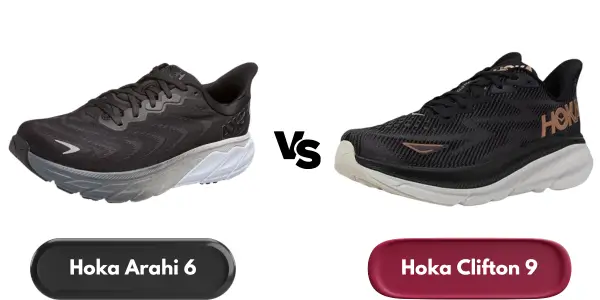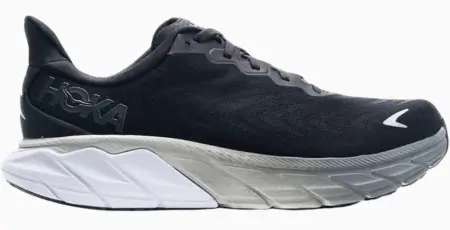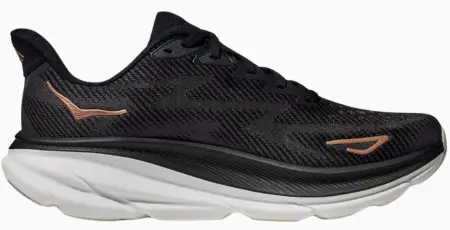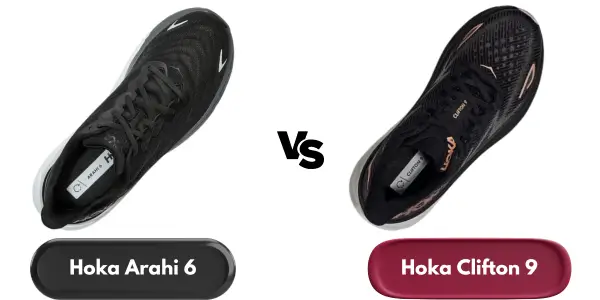Hoka Arahi vs Clifton Running Shoe Key Differences
Last Updated: January 01, 2025 | Author: Jake Thompson
In the competitive sphere of running gear, the rivalry between the Hoka Arahi 6 vs Clifton 9 stands out, each tailored to specific runner needs. The Arahi 6 excels in providing stability for overpronators, while the Clifton 9 offers unparalleled cushioning for a plush ride. This comparison not only underscores the unique attributes of each but also aligns with Hoka's surging popularity, driven by its innovative approach to catering to all types of runners.

Let's dive into what makes these models distinct and see which might best suit your running journey.
Table of Contents:
- Key Takeaways
- Table: Hoka Arahi vs Clifton Main Differences
- Pros & Cons
- Design & Material
- Upper and Midsole Design
- Outsole and Traction Features
- Cushioning and Comfort
- Performance Comparison
- Durability Considerations
- Responsiveness & Stability
- Final Verdict
- Frequently Asked Questions
Key Takeaways
- - Hoka Arahi 6 is a stability shoe with J-Frame technology, while Hoka Clifton 9 is a neutral running shoe suitable for most runners.
- - Hoka Arahi 6 offers medium arch support and is recommended for runners needing stability and corrective features, while Hoka Clifton 9 is recommended for new or neutral runners.
- - Hoka Clifton 9 features ample cushioning and a softer underfoot feel, while Hoka Arahi 6 is more responsive in cushioning.
- - Hoka Clifton 9 is slightly lighter and more durable overall compared to Hoka Arahi 6.
Table: Hoka Arahi vs Clifton Main Differences

|

|
|
|---|---|---|
| Features | Hoka Arahi 6 | Hoka Clifton 9 |
| Terrain | Road | Road |
| Pace | Daily running | Daily running |
| Toebox | Medium | Medium |
| Pronation | Overpronation | Underpronation |
| Cushioning | Firm | Balanced |
| All-day wear | ✓ | ✓ |
| For beginners | ✓ | ✓ |
| Jogging | ✓ | ✓ |
| Treadmill | ✓ | - |
| Walking | ✓ | ✓ |
| Arch support | Stability | Neutral |
| Heel-to-toe drop | 5mm | 5mm |
| Weight | 264g | 249g |
| Widths available | Normal, Wide | Normal, Wide |
| Orthotic friendly | ✓ | ✓ |
| Removable insole | ✓ | ✓ |
| Rocker | ✓ | ✓ |
| Sockless wear | - | ✓ |
| Sustainable | ✓ | - |
| Breathable | ✓ | ✓ |
| Comfortable | - | ✓ |
| Lightweight | - | ✓ |
| Maximalist | ✓ | ✓ |
| Distance | Long distance | Long distance |
| Foot Condition | Plantar fasciitis | Flat feet |
| Collection | Hoka Arahi | Hoka Clifton |
| Strike Pattern | Forefoot/Midfoot strike | Forefoot/Midfoot strike |
| Flexibility | Moderate | Moderate |
| Arch Type | Low arch | High arch |
| Material | Mesh | Knit |
| Forefoot height | 30mm | 27mm |
| Heel height | 35mm | 32mm |
| Price |
Pros & Cons
Hoka Arahi 6
Pros:- - Stability for overpronators with J-Frame technology.
- - Supportive design is ideal for runners needing extra support.
- - Durable and responsive, yet lightweight.
- - Less cushioning than Clifton 9.
- - Slightly heavier, which may affect speed.
Hoka Clifton 9
Pros:- - Plush cushioning for a comfortable ride.
- - Lightweight and breathable, suitable for long distances.
- - Versatile and responsive for smoother transitions.
- - Less stability for overpronators.
- - Slightly more expensive.
Design & Material
In examining the Hoka Arahi and Clifton, the upper and midsole designs are pivotal in addressing different runners' needs.
The Arahi's engineered mesh upper with welded overlays contrasts with Clifton's seamless mesh, offering distinct levels of support and breathability.
Meanwhile, their midsole constructions differentiate in cushioning and stability, with the Arahi's dual-density foam and J-frame catering to overpronators, and the Clifton's EVA foam providing a balanced, plush ride.
Upper and Midsole Design
Delving into the upper and midsole design, it's clear that both shoes have distinct features tailored to their targeted runners' needs.
The Arahi 6, designed as a stability shoe, showcases an engineered mesh upper that provides a secure fit, necessary for those requiring extra arch support. Its J-Frame midsole technology is a hallmark of the shoe, offering a responsive yet cushioned ride while guiding the foot to prevent overpronation.
In contrast, the Clifton 9 also features an engineered mesh upper, but it prioritizes a plush, cushioned experience, aligning with its status as a neutral running shoe. The midsole of the Clifton 9 is designed for balanced cushioning, delivering a soft and responsive feel without the structural guidance provided by Arahi's J-Frame.
Related: Hoka Bondi vs Clifton
Outsole and Traction Features
While considering the upper and midsole design provides insight into the comfort and support levels, it's the outsole design and materials that offer a definitive look at the shoes' traction capabilities and durability on various surfaces.
As road running shoes, both models from the Hoka brand feature outsoles crafted for endurance and reliable grip. The Arahi 6's outsole is equipped with strategic rubber placements, enhancing its longevity.
Meanwhile, the Clifton 9's outsole boasts a design that emphasizes smooth transitions, thanks to its early-stage Meta-Rocker geometry. Durability is a key component for road running, and both shoes offer resilient outsoles that withstand the repetitive impact of the pavement, ensuring a stable and smooth ride.
Cushioning and Comfort
Assessing the cushioning and comfort of the Hoka Clifton vs Arahi reveals that both shoes offer distinct experiences tailored to their intended support mechanisms, with the Clifton 9's plush cushioning contrasting the Arahi 6's firmer, stability-focused design.

When I delve into the specifics:
- - The Clifton 9 employs a full-compression EVA foam midsole that delivers a plush ride. It's renowned for its softer underfoot feel that cushions every step, which is particularly noticeable during longer runs.
- - The Arahi 6, while still utilizing EVA foam, incorporates a firmer dual-density midsole with a J-Frame™ design. This provides the necessary stability for overpronators without the typical rigidity found in stability shoes.
- - Both shoes maintain a moderate heel-to-toe drop, encouraging a more natural foot stride while still offering sufficient underfoot protection and a seamless heel-to-toe transition.
In terms of cushioning and comfort, the Clifton 9 appears to cater to runners seeking a cloud-like feel, while the Arahi 6 will appeal to those who need corrective support without compromising on comfort. The targeted cushioning of each model aligns with the differing needs of runners, ultimately providing a tailored experience that hinges on the balance between softness and structured support.
Related: Hoka vs Brooks Running Shoes
Performance Comparison
The Hoka Arahi, a stability shoe designed for overpronation, incorporates J-Frame technology to prevent the inward roll associated with this condition. It's engineered to deliver a secure and stable ride without sacrificing responsiveness, making it an excellent choice for runners seeking both support and a lively feel underfoot.
The Hoka Clifton, on the other hand, is a neutral shoe celebrated for its lightweight design and balanced cushioning. Its responsiveness is a standout feature, providing a springy sensation that's appreciated during long runs and higher-tempo efforts alike. With a 5mm drop similar to the Arahi, the Clifton offers a versatile platform for a variety of distances and paces.
In performance, these shoes cater to different runner profiles. The Arahi is a stability shoe tailored for those who need extra support, while Clifton's neutrality and lighter weight make it more suitable for runners without specific gait issues.
Both shoes, however, offer the hallmark Hoka cushioning and smooth ride, ensuring that whichever you choose, you won't be compromising on comfort or quality.
| Aspects | Hoka Arahi 6 | Hoka Clifton 9 |
|---|---|---|
| Cushioning | 8/10 (Stability-focused) | 9/10 (Plush, soft) |
| Stability | 9/10 (Excellent for overpronators) | 7/10 (Neutral runners) |
| Responsiveness | 7/10 (Balanced) | 8.5/10 (More responsive) |
| Durability | 8/10 (Enhanced with zonal rubber) | 7.5/10 (Concerns on upper material) |
| Fit and Comfort | 8.5/10 (Stable and comfortable) | 9/10 (Plush and breathable) |
| Support Type | Stability (Overpronators) | Neutral |
| Terrain Suitability | Road running (Excellent traction) | Road running (Versatile performance) |
Durability Considerations
In evaluating the durability, it's essential to consider the materials and construction that contribute to the longevity of these running shoes. Durability considerations are particularly important for runners who frequently engage in long runs, as the demands on their footwear are significantly higher.
Here's what I've found about each running shoe:
- - Hoka Arahi 6: Designed for stability and support with J-Frame technology. Zonal rubber placement on the outsole for durability. Lightweight construction may impact long-term resilience.
- - Hoka Clifton 9: Known for ample cushioning with high-quality EVA foam. Strategic placement of rubber on the outsole for durability without unnecessary weight.
Both Hoka shoes incorporate advanced technologies and materials aimed at extending their life spans. However, the Clifton 9 appears to have an edge in durability due to its balance of cushioning and robust construction. The Arahi 6, while still durable, may show signs of wear more quickly if used extensively for long runs, given its focus on stability rather than cushioning density.
Responsiveness & Stability
While considering the longevity of each model is crucial, it's equally important to examine how the Hoka Clifton 9 vs Arahi 6 performs in terms of responsiveness and stability during runs.
The Arahi 6 is a stability shoe designed to serve runners who need additional support, particularly overpronators who tend to experience more pronation when they run. Thanks to its J-Frame technology, the Arahi offers a dynamic support system that guides the foot without overly rigid materials, striking a balance between support and a responsive ride.
On the other hand, the Clifton 9 caters to neutral runners who typically have a less severe pronation pattern and thus require less corrective support. The cushioning of the Clifton is plush and well-balanced, providing a responsive feel that many runners enjoy.
While both shoes offer a degree of stability, the Arahi 6 emphasizes support and stability for overpronators through targeted engineering, whereas the Clifton 9 focuses more on providing a comfortable and responsive experience for neutral runners.
Each shoe serves a distinct purpose, with the Arahi 6 being the go-to option for those needing corrective support and the Clifton 9 appealing to a broader range of runners seeking a responsive and stable ride.
Final Verdict
Choosing between the Hoka Arahi vs Clifton boils down to your specific needs. If you need stability and support to correct overpronation, the Arahi 6 is unmatched with its J-Frame technology, offering a secure and comfortable ride. However, for those after a soft, plush experience with great responsiveness, especially over long distances, the Clifton 9 is the winner. It's lightweight, cushioned, and versatile, making it ideal for a wide range of runners. In short, Arahi 6 is best for stability, while Clifton 9 excels in cushioning and comfort.
Frequently Asked Questions
1. What are the key differences between Hoka Arahi 6 and Clifton 9?
Arahi 6 is a stability shoe designed to guide your foot and prevent it from rolling, making it ideal for overpronators. Clifton 9, on the other hand, is a neutral shoe that offers a more general cushion and support, catering to a wider range of runners.
2. Do Hoka Arahi 6 and Clifton 9 run true to size?
Yes, both the Arahi 6 and Clifton 9 run true to size, offering a comfortable fit for runners. It's important to note that they also provide options for wide feet, ensuring a good fit for every runner.
3. Which Hoka shoe should I choose if I need a stability shoe?
If you're an overpronator or need a stability shoe to prevent your foot from rolling inward, the Hoka Arahi 6 is your best choice. Its J-Frame technology offers targeted support, making it a stable and supportive option.
4. What features do the Clifton 9 and Arahi 6 share?
Both shoes feature Hoka’s seamless engineered mesh for breathability and comfort, and they are designed to accommodate runners looking for long-distance support. Each shoe also has a nicely padded collar and tongue, ensuring comfort throughout your run.
5. Can you compare the Hoka Arahi vs Clifton for long-distance running?
The Arahi 6, with its stability features and engineered mesh, is an excellent option for overpronators undertaking long distances. The Clifton 9, being a neutral, cushioned shoe, offers broad appeal for long-distance runners seeking comfort and support. Both are equipped for endurance but cater to different runner needs.
6. As a runner concerned about pronation, should I choose the plush cushioning of Hoka's Arahi or Clifton?
If you're a runner concerned about pronation, comparing Hoka's Arahi 6 and Clifton is essential. The Clifton is a neutral shoe, while the Arahi 6 also has engineered midfoot stability. The Arahi 6 is a stiffer, more stable shoe with an engineered mesh toe box, providing some extra support. If you're looking for something plush, the Clifton still provides ample cushioning, making it suitable for runners who want a softer ride.
Share this:







